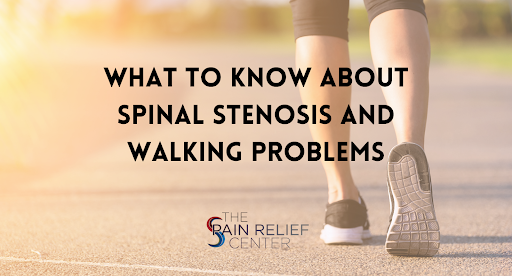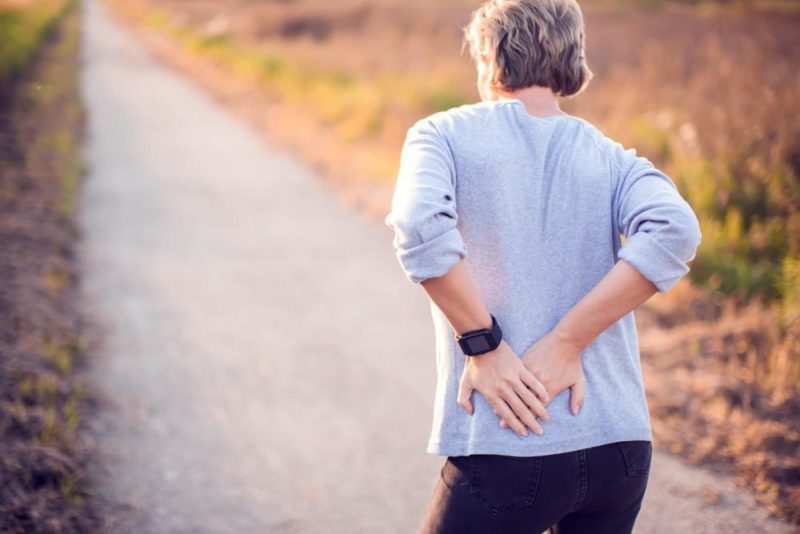According to the American Academy of Orthopedic Surgeons, approximately 8 to 11% of the U.S. population suffers from the pain of spinal stenosis. Most sufferers are over the age of 50, but anyone of any age can experience spinal stenosis. One of the most common issues among lumbar spinal stenosis sufferers is walking difficulties. If you struggle with spinal stenosis and walking problems, doctors at The Pain Relief Center want to give you a better quality of life. Call our spine doctor Plano location today at 214-709-1904 for more information. You can also visit our Texas Spine Institute Dallas location for treatment.
What is Spinal Stenosis?
In short, spinal stenosis is the narrowing of the spinal canal which puts pressure on the spine and pinched nerves in the spinal column. This condition most commonly occurs in the neck and the lower back.
Types of Spinal Stenosis
There are many types of spinal stenosis and it all depends on which sections of the spinal cord are affected by the disease. There are five sections of the spine and they are the cervical, thoracic, lumbar, sacrum, and coccyx sections. Spinal stenosis most commonly affects the cervical spine and the lumbar spine.
- Cervical Spinal Stenosis: Narrowing of the spinal canal in the neck.
- Lumbar Spinal Stenosis: Narrowing of the spinal canal in the lower back. This is the most common type of spinal stenosis.
Symptoms of Spinal Stenosis
Symptoms of spinal stenosis depend on which part of the spinal canal is narrowing. Sometimes, patients don’t have symptoms at all. If symptoms appear, they generally get worse over time.
Cervical Symptoms
Symptoms of cervical spinal stenosis generally include:
- A hand, arm, foot, or leg that’s numb or tingling.
- Hand, arm, foot, or leg weakness.
- Difficulty walking and balancing.
- General neck pain.
- Urinary incontinence, but only in cases of severe spinal stenosis.
- Bowel dysfunction, such as fecal incontinence or constipation. This also only happens in cases of severe spinal stenosis.
Lumbar Symptoms
Symptoms of lumbar spinal stenosis generally include:
- Foot or leg tingling.
- Foot or leg weakness.
- Leg pain or cramping while walking or standing. The pain generally gets better when sitting or bending forward.
- Constant back pain.
Common Causes of Spinal Stenosis
A number of health issues and injuries can unfortunately cause lumbar spinal stenosis and cervical spinal stenosis. The most common causes of this disease are listed below.
- Osteoarthritis is basically the gradual wear and tear of your joints throughout your life. This medical condition is the most common cause of lumbar spinal stenosis and cervical spinal stenosis.
- Bone Spurs. Wear and tear on your spinal bones from osteoarthritis can lead to the development of bone spurs, which can grow into the spinal cord.
- Herniated Disc. Throughout your life, the delicate cushions that serve as shock absorbers between your spinal bones will dry out. Some of the disc’s soft interior material may escape due to cracks in the disc’s exterior. When a disc herniates, it can push on the spinal cord or the spinal nerves.
- Thickened Ligaments. Over time, the tight ligaments that hold your vertebrae together can grow rigid and thick. These swollen ligaments have the potential to protrude into the spinal canal.
- Tumors can grow anywhere inside the spinal cord or the spinal canal. They are generally uncommon in this area of the body, but can certainly be seen in imaging tests such as an MRI or a CT scan.
- Traumatic Injury. A car accident, a fall, a physical assault, or even a sports injury can cause major damage to the spinal cord and spinal nerves. In time, these injuries can certainly lead to lumbar spinal stenosis or cervical spinal stenosis.
Treatment Options for Spinal Stenosis
Your healthcare provider may recommend a variety of treatment options depending on the severity of cervical or lumbar spinal stenosis. Both non-surgical and surgical treatments may relieve pressure and pain.
Non-Surgical Treatments
Your healthcare provider may start by prescribing anti-inflammatory medications, antidepressants, anti-seizure medications, or opioids, all of which can relieve severe pain from nerve damage and spinal stenosis. Your doctor may also recommend physical therapy, steroid injections, massage therapy, chiropractic care, or even acupuncture in order to relieve pain. A non-surgical treatment rarely cures spinal stenosis, but instead may improve your quality of life.
Surgical Procedures
A variety of surgical procedures exist to improve the pain and nerve compression associated with cervical and lumbar spinal stenosis, especially if your non-surgical treatment plan hasn’t been successful. Some of the most common surgical procedures include:
- Laminectomy: This surgery basically discards the back of the vertebrae, also called the lamina. A laminectomy is also called a decompression surgery because it relieves the strain on the surrounding spinal nerves by providing more room for them.
- Laminotomy: This surgery only removes part of the lamina. Generally, creating a small hole is enough to relieve the pressure on the surrounding spinal nerves.
- Laminoplasty: This surgery is best for those who suffer from cervical stenosis, not lumbar stenosis, because it creates more space in the spinal canal through a lamina hinge. Surgeons will then use metal pieces to fill the gap in the spine.
- Percutaneous image-guided lumbar decompression (PILD): Patients who suffer specifically from lumbar spinal stenosis are the only ones who should undergo this minimally invasive surgery. The surgeon basically uses tiny surgical instruments to take out a piece of the thickened ligament that’s causing pain behind the spinal canal. The goal is to create more space in the afflicted area so that nerves are no longer pinched. This surgery is generally performed without general anesthesia.
What is the Link Between Spinal Stenosis and Walking Problems?
Lumbar spinal stenosis is more likely to cause walking problems because it can negatively affect the bundle of nerves at the bottom of your spinal cord. These nerves are called the cauda equina. The cauda equina nerves basically transmit and receive information between your pelvic area and your legs. So lumbar spinal stenosis can frequently interrupt these nerve transmissions, causing walking difficulties.
Cauda Equina Syndrome
Another medical condition that can cause walking difficulties is cauda equina syndrome. Healthcare professionals consider this condition as a medical emergency. If not taken care of immediately, you could suffer permanent nerve damage. Basically, cauda equina syndrome occurs when something in the lumbar region is putting major pressure on the cauda equina nerve roots. It can cause:
- Severe pain in the legs that makes it hard for you to stand or walk
- Loss of bladder or bowel control
- Numbness in your lower body, including in your inner thighs, back of your legs, anal or genital area
Lumbar spinal stenosis can certainly cause cauda equina syndrome. Other causes can include trauma, tumors, or osteoporatic vertebral fractures.
Spinal Stenosis Symptoms While Walking
So, what kind of walking difficulties do lumbar spinal stenosis sufferers specifically struggle with? Some common walking difficulties include:
- Constant pressure and pain in the lumbar region
- Leg pain or buttocks pain
- Tingling or numbness in the legs
- Weak leg muscles
- Foot drop, which is when your foot slaps down on the ground when you walk
You may notice less pain, pressure, numbness, and weakness in the lower body when you’re leaning forward. This is because any position that requires you to lean your spine forward will take pressure off your pinched nerve roots.
Lifestyle Factors That Can Improve Spinal Stenosis and Walking Difficulties
While seeking professional medical advice is crucial in managing lumbar spinal stenosis symptoms, several lifestyle factors can also manage daily discomfort while walking. It’s important to prioritize exercise, physical therapy, diet, sleep, and proper posture while you’re struggling to walk due to this condition.
Exercise
When you suffer with constant pain and walking difficulties every day, the last thing you probably want to do is exercise. However, any low impact exercise is incredibly beneficial for managing lumbar spinal stenosis symptoms. Specifically, exercise can:
- Build stronger back muscles
- Strengthen your core, which ultimately supports and relieves pressure from your back
- Increase oxygen delivery to the connective tissues in your back through blood circulation
- Reduce inflammation due to increased blood circulation
- Increase flexibility everywhere in the body, even in your back and spine
- Enhance bodily range of motion
It’s important to note that the best exercise for lumbar spinal stenosis is exercise that doesn’t cause even more back strain and pressure. So consider these types of exercise:
- Walking, as long as it doesn’t cause even more pain
- Biking
- Swimming or water aerobics
When suffering from a chronic condition like lumbar spinal stenosis, rest is just as important as exercise. Make sure your body feels rested enough for daily movement, or you may not experience as many benefits.
Physical Therapy
Physical therapy was mentioned previously as a non-surgical treatment option for spinal stenosis symptom management. But a physical therapist can also teach you how to:
- Improve your walking difficulties, such as foot drop
- Strengthen your back, core, and leg muscles
- Stretch appropriately
- Improve mobility so that you can exercise daily
Implementing all of the recommendations from your physical therapist can also help you prevent further injury.
Diet
A healthy, balanced diet benefits every single system, bone, and muscle group in the human body. A lifetime of healthy eating can help prevent a multitude of chronic illnesses and diseases. Additionally, the proper foods give you the energy you need to exercise regularly so that you can manage your lumbar spinal stenosis symptoms. Make sure to eat plenty of:
- Vegetables and fruits
- Grains and legumes
- Healthy animal proteins
- Healthy fats
Additionally, avoid consuming too much alcohol, refined sugars, and highly processed foods.
Sleep
A study from the NIH claims that 63.5% of lumbar spinal stenosis sufferers also struggle with poor sleep. Additionally, the study claims that poor sleep can exacerbate preexisting pain and discomfort from this condition. Therefore, you must prioritize good quality sleep in order to manage pain and promote healing. Listed below are some tips to improve your sleep quality:
- Get into the habit of going to sleep and waking up at the same time every day. This will get your body into a routine and eventually cause you to feel sleepy at the same time every night.
- Avoid watching TV or looking at your phone right before bed time. Screens emit lots of blue light which can prevent proper melatonin production.
- Exercise most days of the week. At least 30 minutes of movement is enough to “wear you out” and make you feel sleepy at the end of the day.
- Stop drinking caffeine four to six hours before bed time so that your body will feel sleepy instead of jittery and energized at the end of the day.
- Buy a comfortable mattress that doesn’t make your back pain worse while you sleep.
Posture
Good posture is also essential for managing pain while walking. Slouching can cause even more pain and pressure in your lumbar region, so make sure to stand up straight with your shoulders pulled back. Also, hold your head and neck straight. Make sure you’re not craning your neck forward.
Call The Pain Relief Center Today
If you’re suffering from cervical or lumbar spinal stenosis, doctors at The Pain Relief Center want to ensure that you can have the best quality of life possible. We have decades of experience in improving our patient’s spine health and daily mobility issues. For more information on how we can help you, call 214-709-1904 today.



